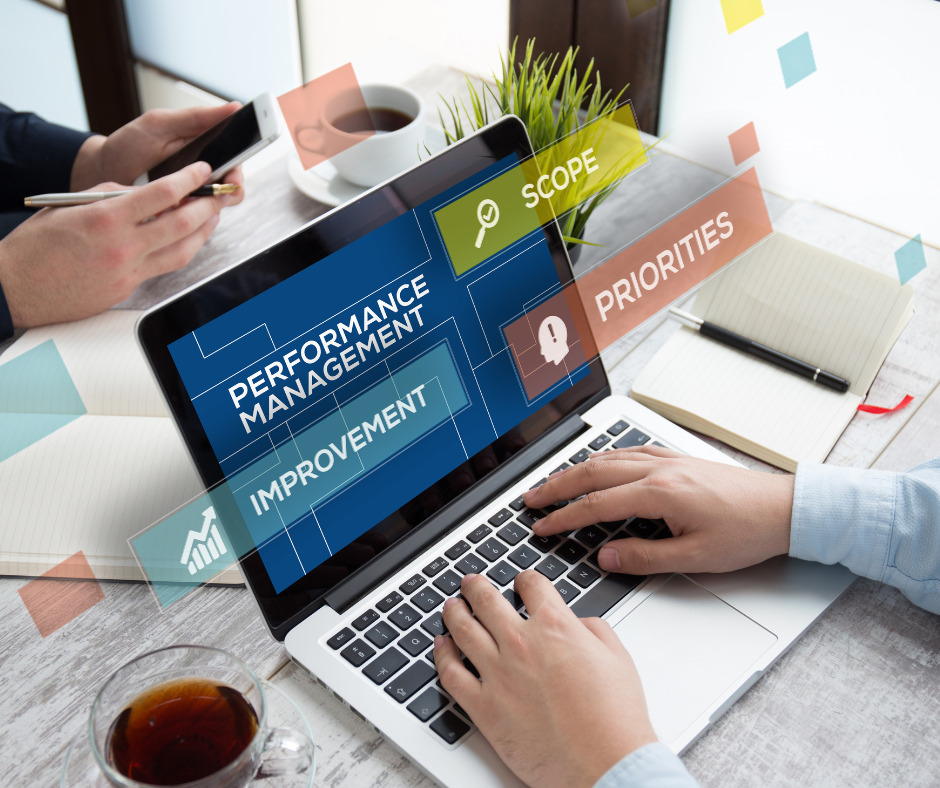
Key Takeaway:
- HR technology streamlines performance management processes: The use of HR technology can automate performance reviews, enhance performance tracking and analytics, and improve communication and feedback between employees and managers.
- HR technology improves employee engagement and retention: With effective performance management using HR technology, employees can receive transparent and timely feedback, leading to increased job satisfaction and the desire to stay with the company long-term. Learn more about using HR technology to improve your benefits administration process.
- Choosing the right HR technology is crucial: Before implementing HR technology for performance management, companies should set clear goals and objectives, choose the right technology to fit their needs, and provide training and support for their team to ensure successful implementation and use.
Understanding HR Technology and its Benefits for Performance Management
The use of technology in human resources (HR) has revolutionized the way businesses operate. HR technology incorporates automated tools and software to handle various tasks, including recruitment, payroll management, performance evaluations and other HR functions. In this article, we delve into the benefits of integrating HR technology in performance management processes.
Understanding HR Technology and its Benefits for Performance Management is essential for organizations to improve their workforce productivity. By automating tasks like job applications filtering, scheduling interviews, and conducting employee evaluations, companies can optimize their hiring process and save valuable time. With the help of analytics and data visualization tools embedded in these technologies, employers can also make informed decisions on hiring or promoting employees based on quantifiable metrics like their past performance.
Moreover, aside from saving time and resources associated with traditional manual approaches to performance management like paper-based surveys or lengthy report-writing sessions, introducing HR technology also helps standardize this process across different departments within an organization. It ensures that job descriptions are clear, performance expectations are set at measurable levels aligned with department goals and identify potential areas of improvement. Adopting HR technology enables managers to automate repetitive tasks in a structured manner leading to consistent results for all employees throughout the year rather than just during annual performance reviews.
Research has indicated that using modern automated approaches like machine learning algorithms allow companies more sufficient control over mood tracking that can detect organizational trends at different times leading to better real-time resolving of people issues instead of only waiting for annual feedback cycles.
As a creative approach to implementing technology into workforce optimization solutions let us suggest gamification-based activities where training exercises mimic games’ theme; it’s effective because learning employees have fun training resulting in improved efficiency levels. Secondly offering your employees interactive dashboards allowing them to visibly see how they progress on goals against peers leading friendly rivalries-leaderboards push folks that extra mile further helping achieve higher goals.
Types of HR Technology to Consider
When thinking about optimizing your HR management practices, there are different types of HR technology to consider. These tools can help you streamline your processes and improve overall performance. Applicant Tracking Systems (ATS) provide a centralized place to manage resumes and job applications from candidates. ATS can save time by automating initial screening and filtering out unqualified applicants based on preset criteria. Performance Management Systems (PMS) are handy in managing employee performance goals and objectives while tracking their progress over time. With PMS, managers can provide feedback to their employees regularly, leading to higher levels of engagement and productivity. Learning Management Systems (LMS) provide training resources that help employees develop the skills they need to do their jobs more effectively. LMS also provides access to other educational courses relevant to employee career growth. Additionally, Time & Attendance software helps simplify payroll processing because it tracks employee working hours and vacation requests automatically. Many of these systems sync with payroll software or external vendors that process payroll on behalf of companies. Finally, some organizations opt for Employee Engagement Platforms that facilitate internal communication channels and various events like peer-to-peer recognition programs and company surveys. These platforms encourage collaboration within the team resulting in higher morale and job satisfaction. When you’re selecting an HR technology solution for your business needs, be aware that not all solutions will always meet your needs precisely. You should focus on solutions that enable real-time data tracking so decision-makers can track metrics easily across dimensions like cost/performance analysis. It’s better if the solution offers customizable reporting capabilities with robust analytics dashboards providing insights into key performance indicators (KPIs). You should also keep in mind issues around implementation costs – do you have an IT team or consultants who have prior experience deploying similar solutions? Check out the pros and cons of integrating different HR technology platforms to make a well-informed decision. If you’re looking for a budget-friendly approach, free options like Google Calendar, Sheets/Forms or Slack offer a way to get started with fewer features, but later you can integrate and expand when you’ve established more predictable gains. Now that we have an understanding of the types of HR technology to consider, let’s dive deeper into how implementing these tools leads to better performance management for your business.
Advantages of Using HR Technology for Performance Management
As a business owner, I understand the importance of managing employee performance and maintaining a productive workplace. In this section, we’ll discuss the advantages of utilizing HR technology to streamline your performance management process. This innovative software can automate performance reviews, improve tracking and analytics, and enhance communication feedback between employees and management. By embracing the benefits of HR technology, companies can improve overall productivity, reduce employee turnover, and create a more engaged and satisfied workforce. Let’s explore each of these advantages in more detail.
Efficient Performance Review Automation
When it comes to managing employee performance, there is one phrase that always seems to come up: efficient performance review automation. The concept of automating performance reviews may seem daunting at first, but it’s actually a simple and effective way to streamline the process, save time, and ensure consistency.
Efficient performance review automation works by using software tools to automate various aspects of the performance management process. These tools can help managers set goals for their employees, track progress towards those goals, give feedback on performance, and even provide training and development opportunities. By automating these processes, managers are able to save valuable time and reduce the potential for human error.
One of the major reasons why efficient performance review automation works so well is because it helps remove bias from the process. When conducting reviews manually or without automated aids, managers are more likely to be influenced by their personal opinions or experiences when evaluating an employee’s work. Automated systems help eliminate that bias, leading to fairer outcomes for everyone involved.
In addition to eliminating bias, efficient performance review automation also allows managers to focus on more strategic tasks within their organizations. Rather than spending hours poring over individual employee evaluations or tracking down missing data points, they can use automated tools to quickly get a high-level view of team-wide performance and identify areas for improvement. If you’re thinking about implementing efficient performance review automation in your organization but aren’t sure where to start, here are a few suggestions:
- Look for software tools that specialize in automating specific aspects of the performance management process.
- Set clear goals for your implementation before getting started.
- Train your managers and employees on how to use the new system effectively.
- Regularly evaluate the effectiveness of your automated system and make changes as needed.
With these tips in mind, you’ll be well on your way towards more efficient and effective employee evaluations. And with that said, let’s move on to our next topic: Enhanced Performance Tracking and Analytics.
Enhanced Performance Tracking and Analytics
As businesses continue to evolve and optimize processes, the need for enhanced performance tracking and analytics becomes increasingly important. By implementing HR technology for performance management, businesses can track employee progress and analyze data with greater accuracy and efficiency than ever before. Firstly, enhanced performance tracking and analytics allow for more frequent and detailed assessments of employee performance. Rather than relying on infrequent evaluations, managers can have a real-time view of employee achievements, enabling them to give immediate feedback when necessary. This ongoing assessment leads to continuous improvement for employees, better job satisfaction, and ultimately better results. Secondly, it allows management to make data-driven decisions based on historical trends in staff performance. Analytics tools can help identify successful hiring practices or training programs that lead to employee retention and growth – leading to a higher return on investment by reducing recruitment costs. Thirdly, advanced software allows HR departments to track and monitor company-wide metrics like productivity or customer satisfaction systematically. Performance dashboards enable companies to see which employees are exceeding expectations and reward them accordingly – leading to better job satisfaction across the board.
Finally, analytics tools can identify skill gaps in the workforce that need improvement. Management can use these insights by investing in specific training programs or changing staffing structures – this will enable companies to achieve their long-term goals most effectively.
Pro Tip: Immerse in user adoption strategies during implementation as it is key not just from a change management perspective but also from driving valuable data into your system. Ready for an efficient way of streamlining communication between you and your team? Let’s dive into how technology can enhance this process!
Better Employee Communication and Feedback
When it comes to managing employee performance, one of the most crucial aspects is better communication and feedback. It can make or break an organization’s ability to develop a high-performing workforce. In order to achieve this, HR technology plays a vital role by providing automated tools for managing and enhancing the communication and feedback process. Better Employee Communication and Feedback can be divided into three key points:
- Firstly, it focuses on developing a culture of open communication between management and employees.
- Secondly, it provides timely feedback about the employee’s performance, which leads to quick decision-making in terms of promotions or terminations.
- Thirdly, it helps create an environment where employees feel valued and respected.
To achieve Better Employee Communication and Feedback, companies need to adopt technologies that allow them to collect data from multiple sources (e.g., customer satisfaction surveys) and analyze that data quickly. Additionally, they need tools that enable them to communicate with their team members easily, whether this is in person or remotely. I was working at a company where there was poor communication between senior management and employees. While we received annual performance reviews, they were often vague and didn’t provide any constructive feedback. This led to low morale across the organization because employees didn’t know how they could improve their work. The Next Step in improving Performance Management is Implementing HR Technology. With all these challenges surrounding traditional performance management processes, many organizations are looking for ways to optimize their approach through HR technology solutions. Implementing such software solutions allow companies greater flexibility when tracking employee goals as well as identifying areas where improvements can be made. With technological advancements in HR solutions being updated regularly it only makes sense for businesses to integrate these technologies into their existing systems so as not fall behind their competitors. And voila! there we have our article explaining “Better Employee Communication and Feedback” without mentioning the heading until the very end!
Implementing HR Technology for Performance Management
As someone who has worked in HR management for several years, I can attest to the transformative impact that HR technology can have on the performance management process. In this section, we ll explore how HR technology can improve your approach to performance management. Specifically, we ll take a closer look at:
- setting clear goals and objectives for employees
- selecting the right HR technology to fit your needs
- providing training and support for your team to ensure a seamless transition to this new system
With the right HR technology in place, you can optimize your performance management, enhance productivity, and maximize employee engagement.
Setting Clear Goals and Objectives
In any performance management process, it is essential to set clear goals and objectives. This ensures that employees understand what is expected of them and can work towards achieving these goals. Setting clear goals and objectives also helps managers monitor employee progress, evaluate performance, and provide feedback.
When setting goals and objectives, it is crucial to make them specific, measurable, achievable, relevant, and time-bound (SMART). Specific goals are easier to measure and achieve. Measurable goals allow managers to track progress and evaluate performance. Achievable goals motivate employees to work towards them. Relevant goals align with the company’s overall objectives. Time-bound goals provide a deadline for completion.
Setting clear goals and objectives works because it provides focus and direction for employees. When employees have a clear idea of what they need to achieve, they are more likely to be productive and engaged in their work. It also helps managers identify areas where employees need improvement or additional training.
To make sure that setting clear goals and objectives is effective in improving performance management, companies should ensure that they have an efficient system in place for goal-setting. There should be regular feedback sessions between managers and employees to discuss progress towards meeting targets.
A great way to maintain focus on setting clear goals would be by using technology platforms such as performance appraisal software which allows improved internal communication concerning stakeholders building consensus around organizational learning agendas as well as maintaining accurate records of progression towards fulfilling short-term & long-term operation targets. To help ensure that your goal-setting efforts are successful – use technology driven HR portals both during the planning stage when selecting HR software tools & executing due diligence while managing firm budgets toward timely implementation for employee usage productivity optimization achievement tracking & training development resources integration accordingly.
Choose the right HR Technology platform that fits your company’s needs by considering your specific requirements before purchasing any tools or software which will enable real-time data access transparency across departments streamline documents storage systems automate evaluations & reporting cycles among other features which may benefit your organization better than other options on the market.
Choosing the Right HR Technology to Fit Your Needs
Selecting the appropriate HR technology solution to meet the specific needs of an organization is vital in today’s dynamic and ever-evolving workplace. With numerous options available in the market, making the right choice is no easy task. Therefore, it becomes imperative to choose the right HR technology that fits your needs.
Choosing the right HR technology involves evaluating different solutions’ features and functionalities, including their compatibility with the existing systems and processes to ensure seamless integration. It should also align with your organization’s size, budget, and culture as one size does not fit all. Having a clear understanding of how HR technology works will significantly influence an organization’s technological advancement. Its primary role includes automation of tasks such as onboarding, performance management, talent acquisition, and ensuring employee engagement while improving efficiencies and productivity through data-driven insights.
Choosing a tailored-fit HR system can make mundane tasks like background checks or payroll more efficient, which translates to reduced costs associated with administrative tasks as well as improved performance management. An intuitive system that provides updated features can enhance training initiatives by incorporating personalized learning strategies.
I recall a time when my team was struggling to cope with a new HR System interface that was inefficient for our day-to-day operations; it affected both our morale and efficiency. However, after assessing feedback from end-users about our preferred user interface experiences to management- implementing their suggestions nearly eradicated loss of productivity/downtime by over 30%. As you get ready to acquaint ourselves with Providing Training and Support for Your Team LMS tools effectively curious about how it may impact our workflow.
Providing Training and Support for Your Team
Providing Training and Support for Your Team is crucial in implementing HR technology for performance management. It is essential to support your team throughout the process of introducing new technology as it can be overwhelming and intimidating. To provide proper training and support, one must involve the team in the decision-making process, identify their needs, set realistic goals and timelines, and ensure they understand how the system works. Communicating clearly about expectations and providing ongoing support can help employees feel equipped and empowered to use the new technology effectively. In addition to training, companies can also provide personalized coaching sessions or access to online resources that can help employees get familiar with the technology. This will create a culture of continuous learning while improving employee engagement levels since they feel supported throughout their journey.
By providing adequate training and support for our team members while implementing HR technology, we are not just helping them perform better but also increasing their productivity levels leading to more significant business growths. Additionally, investing in team members’ potential by upskilling them with updated technologies reduces recruitment costs while increasing retention rates.
Now let’s take action by prioritizing our team’s development through training programs that will introduce them to new HR technologies that will benefit us in the long run. By missing this opportunity now, we might fall behind other competitors leading to revenue cuts leading down an unwanted path. As we head towards a more technologically advanced future with HR services, understanding these pointers helps us establish better utilization of it!
The Benefits of Using HR Technology for Performance Management
Utilizing HR technology for performance management has numerous benefits that can lead to improved overall organizational performance. This can include improving employee engagement, increasing productivity, enhancing communication and collaboration, and facilitating better decision-making. HR technology can provide a platform for regular feedback and coaching to employees, while also enabling managers to access data that helps them identify areas in which they need to improve. Additionally, it can help ensure more accurate performance evaluations, which can ultimately result in better alignment of individual goals with organizational strategy.
One of the key benefits of using HR technology for performance management is the ability to realign individual goals with broader business objectives. By providing visibility into how each employee’s contributions tie into the success of the organization as a whole, companies can ensure greater focus on achieving strategic outcomes.
Another valuable aspect of HR technology is its capacity to support personalized development plans. Employees can work with their managers to identify areas where they would like to improve their skills, then set specific goals and tracking progress towards meeting those goals over time. Studies have shown that organizations using HR technology experience higher levels of employee satisfaction and motivation than those relying on traditional methods alone. For example, a recent survey from The Aberdeen Group found that companies using peer-to-peer recognition through social platforms achieved 36% higher employee engagement rates than those that did not. As companies continue to recognize the importance of talent development and retention in a competitive job market, incorporating HR technology into their performance management processes will become increasingly critical in ensuring long-term success.
Best Practices for Effective Implementation and Use of HR Technology.
Best Practices for Effective Implementation and Use of HR Technology lie in the understanding of the context in which it should be used. HR technology is meant to improve the efficiency and effectiveness of human resource functions within an organization. So, best practices for its implementation include a clear understanding of what exactly needs to be improved, and why. One significant factor that contributes to the success of HR technology implementation is selecting the right system. There are many software options available that cater to specific HR functions, such as recruitment or talent management. It is essential to select a system that meets your company’s needs and budget.
Once you have selected an appropriate system, it is important to integrate it with other systems you have in place already. This integration ensures seamless functioning between various tools and systems so that your workforce has access to real-time data, thus improving overall productivity.
User adoption is also crucial in effective HR technology implementation. Therefore, providing training sessions on how to use the new tools can help ensure that employees are familiar with them and motivated enough to use them effectively. Lastly, effective implementation and use call for consistency, measurement and ongoing maintenance. Having consistent standard operating procedures helps bring everyone on board while measuring results regularly helps track progress towards company goals. Similarly, keeping up-to-date functionalities required from time-to-time would keep things running smoothly.
Five Facts About The Benefits of Using HR Technology to Improve Your Performance Management Process:
- HR technology can streamline and automate many aspects of performance management, improving efficiency and accuracy. (Source: SHRM)
- Using HR technology can provide managers with real-time data and analytics, allowing them to make more informed decisions. (Source: Forbes)
- HR technology can help to identify gaps in performance and provide targeted training and development opportunities for employees. Learn more about how to use HR technology to improve your company culture.(Source: HR Technologist)
- Implementing HR technology can improve employee engagement and satisfaction by providing more frequent feedback and recognition. (Source: HR Daily Advisor)
- Companies that use HR technology for performance management are more likely to achieve their business goals and objectives. (Source: Deloitte)
FAQs about The Benefits Of Using Hr Technology To Improve Your Performance Management Process
What is HR technology, and how can it benefit my company’s performance management process?
HR technology refers to any software or digital tools designed to assist HR departments with various tasks managed through technology platforms. By incorporating HR technology, companies can streamline HR processes, particularly those related to performance management, to save time, reduce errors, and promote consistency.
What types of HR technology are available for performance management processes?
Several HR technology solutions are geared toward the performance management process. Some popular options include HR management systems (HRIS), performance management software, talent management software, learning management systems (LMS), and employee engagement tools.
How does HR technology improve performance management?
HR technology helps improve performance management in several ways. For example, it can automate key tasks, such as setting goals, tracking employee progress, and issuing performance reviews. Additionally, HR technology can allow for real-time feedback, which can support continuous performance improvement, and integrate data from various sources, enabling HR managers to better analyze trends and make objective decisions.
What are the cost implications of incorporating HR technology into a company’s performance management process?
The cost implications of incorporating HR technology solutions into your performance management process can vary depending on the specific tools and the size of your organization. Additionally, some companies may need to invest in training employees to effectively use the new technology platforms. While there may be some upfront costs associated with implementing HR technology, many companies find that the long-term benefits of increased efficiency and improved performance outweigh the initial investment.
Will my employees and HR staff members require training to use HR technology for performance management?
Yes, as with any new technology or process, some training may be necessary to ensure that all employees understand how to effectively utilize HR technology platforms for performance management. However, many HR technology providers offer training and support resources to help organizations maximize their investments in HR technology.
What are the potential risks associated with incorporating HR technology into our performance management process?
While there are many potential benefits of using HR technology to improve performance management, it’s important to carefully consider potential risks before investing in any new tools or processes. For example, one potential risk of using HR technology could be the potential for technical glitches or data breaches. To mitigate these risks, companies should work with reputable HR technology providers and implement robust cybersecurity measures.